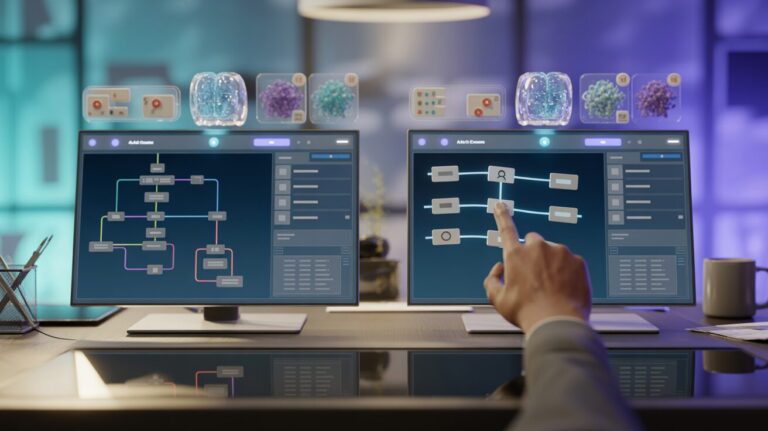Table Of Contents
- Introduction
- Understanding AI in Education: Transforming Teaching and Learning
- Key Features to Evaluate in AI Educational Tools
- Top AI Platforms for Educators Compared
- Implementation Considerations: Bringing AI into Your Classroom
- No-Code Solutions: The Future of Educational AI
- Measuring Success: Evaluating AI Impact on Learning Outcomes
- Conclusion: Selecting the Right AI Educational Platform
The educational landscape is undergoing a profound transformation, with artificial intelligence emerging as a powerful catalyst for change. Today’s educators face mounting pressures: personalizing instruction for diverse learners, managing administrative workloads, and preparing students for an increasingly digital future. AI tools offer promising solutions to these challenges, but navigating the growing marketplace of educational technology can be overwhelming.
Whether you’re a classroom teacher looking to streamline grading, a curriculum developer seeking content creation assistance, or an administrator working to implement school-wide technology initiatives, finding the right AI platform is crucial. This comprehensive guide compares leading AI tools designed specifically for educational contexts, highlighting their strengths, limitations, and optimal use cases.
We’ll explore how these platforms are revolutionizing instruction through automated assessment, personalized learning pathways, content generation, and classroom management—all while considering practical implementation factors like ease of use, technical requirements, and privacy considerations. By the end of this article, you’ll have a clear framework for evaluating which AI educational tools align with your specific teaching goals and institutional needs.
AI Tools for Educators: Platform Comparison
A comprehensive analysis of leading AI platforms transforming education
Why AI in Education Matters
Personalizes learning experiences
Automates administrative tasks
Provides data-driven insights
Top AI Educational Platforms Compared
| Platform Category | Leading Tools | Key Strengths |
|---|---|---|
| Content Creation | Nearpod AI, Canva Education, KidsAI | Transform static content into interactive materials |
| Personalized Learning | DreamBox Learning, Century Tech, Cognii | Adapt content difficulty based on individual performance |
| Assessment & Feedback | Gradescope AI, Turnitin GradeMark, Feedback Fruits | Streamline grading and provide detailed feedback |
| Classroom Management | ClassDojo, Sprinkle AI Attendance, TeachFX | Track participation and identify classroom patterns |
| No-Code Solutions | Estha, other custom builders | Create custom AI applications without technical expertise |
Key Features to Evaluate
Ease of Use
Consider intuitive interfaces that don’t require technical expertise
Customization
Evaluate ability to align with specific curriculum and teaching approaches
Data Privacy
Ensure compliance with educational privacy regulations like FERPA
Implementation Keys
- Professional Development: Ensure adequate training resources
- Incremental Adoption: Start small and expand gradually
- Privacy Protection: Establish clear consent procedures
- Equity Considerations: Account for diverse learning needs
Measuring Success
Quantitative Learning Gains
Track improvements in knowledge retention and skill application
Time Efficiency
Measure reduced administrative workload
No-Code Solutions: The Future of Educational AI
Create custom AI applications without technical expertise using platforms like Estha
Subject-Specific Assistants
Custom teaching assistants
Assessment Bots
Aligned with curriculum
Feedback Systems
For unique assignments
Understanding AI in Education: Transforming Teaching and Learning
Artificial intelligence in education (AIEd) represents more than just a technological trend—it’s fundamentally changing how educators teach and how students learn. At its core, AIEd uses machine learning algorithms and data analysis to adapt to individual student needs, automate routine tasks, and provide insights that would be impossible to gather manually.
The most transformative aspect of AI in education is its ability to personalize learning experiences. Traditional classroom models often struggle with the “one-size-fits-all” approach that fails to address the unique needs of each student. AI systems can analyze performance patterns, identify knowledge gaps, and adjust content difficulty in real-time, creating truly adaptive learning experiences that meet students where they are.
Beyond personalization, AI streamlines administrative tasks that typically consume educators’ valuable time. From automated grading of objective assessments to plagiarism detection and attendance tracking, these tools free up teachers to focus on what matters most: meaningful interaction with students and creative instructional design.
However, it’s important to recognize that AI tools aren’t meant to replace educators. Rather, they serve as powerful amplifiers of teachers’ capabilities, handling routine tasks while allowing human expertise to focus on the nuanced aspects of education that require emotional intelligence, ethical judgment, and creative thinking—areas where technology still falls short.
Key Features to Evaluate in AI Educational Tools
When assessing AI platforms for educational use, several critical factors should guide your decision-making process:
Ease of Use and Technical Requirements
The most powerful AI tool provides little value if educators struggle to implement it. Look for platforms with intuitive interfaces that don’t require programming knowledge or extensive technical training. Consider whether the tool requires specialized hardware, consistent internet connectivity, or complex integration with existing systems.
Customization Capabilities
Every educational environment has unique needs based on subject matter, student population, and instructional approach. Evaluate whether the AI platform allows for customization of content, assessment parameters, and learning pathways. The ability to align AI tools with your specific curriculum and teaching style significantly impacts their effectiveness.
Data Privacy and Security
Educational AI tools necessarily collect and analyze student data to function effectively. Ensure any platform you consider adheres to educational privacy regulations (such as FERPA in the US or GDPR in Europe) and employs robust security measures to protect sensitive student information. Transparent data policies should clearly explain what information is collected and how it’s used.
Evidence of Efficacy
The educational technology market is filled with bold claims about improved outcomes. Look for platforms that can demonstrate real-world impact through case studies, peer-reviewed research, or verifiable data on learning improvements. The most valuable AI tools are those with proven track records in contexts similar to your own.
Integration Capabilities
Few educational institutions can afford complete system overhauls. Evaluate how well an AI platform integrates with your existing digital ecosystem, including learning management systems, student information databases, and communication tools. Seamless integration reduces implementation friction and increases adoption rates among staff and students.
Top AI Platforms for Educators Compared
The educational AI landscape spans several functional categories, each addressing different aspects of teaching and learning. Let’s examine standout platforms across these categories to help you identify which might best serve your specific educational needs.
Content Creation Tools
Nearpod AI: Specializes in transforming existing lesson materials into interactive, multimedia presentations. Its strength lies in automating the conversion of static content into engaging activities, saving significant preparation time. However, educators report occasional inconsistencies in how complex subject matter is rendered.
Canva Education with Magic Studio: Combines design simplicity with AI capabilities to help teachers create visually compelling educational materials. Its image generation and text-to-design features make professional-quality visual aids accessible to non-designers, though the AI sometimes struggles with highly specialized academic content.
KidsAI: Focuses specifically on K-8 content creation with age-appropriate language and examples. Its specialized algorithms ensure content matches developmental levels, but this specificity means it offers limited utility for secondary and higher education contexts.
While these platforms excel at generating instructional content, many educators find they need to supplement with tools that can create customized assessment materials or specialized interactive components. This is where no-code AI builders like Estha provide valuable flexibility, allowing educators to develop tailored applications that address specific pedagogical needs without requiring technical expertise.
Personalized Learning Platforms
DreamBox Learning: Primarily focused on mathematics, this adaptive platform continuously adjusts problem difficulty based on student performance. Its strength lies in detailed skill progression mapping and real-time adjustments, though some users note limitations in supporting collaborative learning models.
Century Tech: Offers micro-learning modules across multiple subjects that adapt based on individual learning patterns. The platform’s memory algorithms are particularly effective at optimizing review schedules, but implementation requires significant initial content mapping.
Cognii Virtual Learning Assistant: Employs natural language processing to provide conversational tutoring and assessment across subjects. Its ability to evaluate free-response answers beyond simple multiple-choice formats sets it apart, though accurate assessment of complex responses remains challenging in certain subject areas.
The personalization capabilities of these platforms represent significant advances over traditional one-size-fits-all instruction. However, educators often report challenges in customizing these systems to align perfectly with their specific curriculum sequences or pedagogical approaches. Custom AI solutions that can be tailored to specific instructional methodologies offer a compelling alternative, particularly for specialized educational contexts.
Assessment and Feedback Tools
Gradescope AI: Specializes in automating assessment of handwritten work, particularly in STEM fields. Its optical character recognition capabilities and rubric-based scoring dramatically reduce grading time for math problems and diagrams, though it requires careful calibration for optimal accuracy.
Turnitin GradeMark with AI: Combines plagiarism detection with AI-powered feedback suggestions on writing assignments. The platform excels at identifying structural writing issues and suggesting improvements, but human judgment remains essential for evaluating nuanced arguments and creative expression.
Feedback Fruits: Focuses on peer-assessment workflows enhanced by AI guidance. Its unique approach uses AI to train students in giving better peer feedback, though this indirect approach means results depend heavily on student engagement levels.
These assessment tools demonstrate AI’s capacity to dramatically reduce educator workload while potentially increasing feedback frequency and specificity. However, most successful implementations maintain a balance between automated and human evaluation, particularly for complex, open-ended assignments.
Classroom Management AI
ClassDojo with AI Insights: Enhances its popular behavior management platform with pattern recognition to identify classroom dynamics. The system can highlight potential intervention points and engagement patterns, though some educators express concerns about potential behavioral labeling effects.
Sprinkle AI Attendance: Automates attendance tracking through facial recognition and pattern analysis. Its efficiency in large classroom settings is notable, but implementation requires careful attention to privacy considerations and appropriate consent mechanisms.
TeachFX: Analyzes classroom discourse patterns to provide insights on participation equity and questioning techniques. This reflective tool helps teachers improve discussion facilitation, though it sometimes struggles with specialized technical vocabulary in certain subject areas.
These management tools illuminate classroom dynamics that might otherwise remain invisible, offering educators unprecedented insights into interaction patterns, engagement levels, and potential intervention points. The most successful implementations use these tools as starting points for reflective practice rather than as definitive evaluations.
Implementation Considerations: Bringing AI into Your Classroom
Successfully integrating AI tools into educational environments requires thoughtful planning beyond simply selecting the right platform. Consider these critical implementation factors:
Professional Development Support
Even user-friendly AI tools require training for effective implementation. Evaluate what professional development resources accompany each platform. Look for options offering ongoing support rather than just initial training, including tutorial libraries, user communities, and responsive technical assistance.
Incremental Implementation
Successful adoption typically follows a gradual approach rather than wholesale transformation. Consider platforms that allow for modular implementation, where educators can begin with a limited feature set and expand usage as comfort and competence grow. This phased approach reduces resistance and implementation fatigue.
Student Privacy Protections
Beyond general data security, consider the specific privacy needs of your educational context. This includes appropriate parental notification and consent procedures, transparent data retention policies, and alignment with institutional ethical guidelines around student data use.
Equity Considerations
AI systems can inadvertently amplify existing biases or create new access barriers. Evaluate whether platforms account for diverse learning needs, linguistic variations, and cultural contexts. Consider also the hardware and connectivity requirements that might impact equitable access across different student populations.
Educational institutions that have successfully implemented AI tools typically report that technical challenges are often less significant than cultural and procedural ones. Creating a supportive implementation environment—with clear communication, appropriate incentives, and visible administrative support—often proves more crucial than the specific technical features of any given platform.
No-Code Solutions: The Future of Educational AI
While pre-built AI education platforms offer valuable functionality, they sometimes constrain educators to predetermined workflows that may not perfectly match specific educational contexts. This limitation has driven growing interest in no-code AI development platforms that empower educators to create custom AI solutions without programming expertise.
Estha represents this emerging category of educational technology, allowing teachers to build personalized AI applications through an intuitive drag-drop-link interface. This approach addresses a significant gap in the educational AI landscape: the need for customization without technical complexity.
With no-code platforms like Estha, educators can create specialized applications including:
- Subject-specific virtual teaching assistants that reflect departmental teaching methodologies
- Custom assessment bots that align perfectly with specific curriculum standards
- Interactive learning scenarios tailored to particular student populations
- Specialized feedback systems designed for unique assignment types
The key advantage of this approach is educational sovereignty—teachers maintain complete control over the AI’s functionality and behavior rather than adapting their teaching to fit pre-built systems. This preserves pedagogical autonomy while still leveraging AI’s capabilities.
No-code platforms also solve another common challenge: integration with existing educational ecosystems. Custom-built applications can be designed specifically to complement current workflows rather than requiring wholesale system changes. For institutions with established digital environments, this targeted approach often proves more sustainable than adopting comprehensive but inflexible platforms.
Educational institutions from K-12 districts to universities have reported success with this approach, particularly for specialized applications where commercial offerings lack sufficient customization options. As AI becomes increasingly central to education, the ability to create tailored applications without technical barriers represents a significant democratization of this powerful technology.
Measuring Success: Evaluating AI Impact on Learning Outcomes
Implementing AI tools represents a significant investment of resources, making systematic evaluation of their impact essential. Effective assessment frameworks typically consider multiple dimensions:
Quantitative Learning Gains
While standardized assessment scores provide one metric, consider developing more nuanced measures aligned with your specific learning objectives. This might include knowledge retention rates, skill application success, or problem-solving efficiency. The most meaningful evaluations typically track longitudinal data rather than simple before-and-after comparisons.
Time Efficiency
Many AI tools promise to save educator time, but this benefit should be systematically measured. Document time investments in both implementation and ongoing use, and compare against baseline measurements of traditional approaches. Remember to account for initial learning curves that typically flatten with continued use.
Engagement Metrics
Student interaction patterns often reveal important information about AI tool effectiveness. Consider metrics like voluntary usage rates, session duration, question-asking frequency, and persistence through challenging content. These behavioral indicators often predict learning outcomes and highlight areas for refinement.
Accessibility Improvements
For many institutions, expanding educational access represents a primary motivation for AI adoption. Evaluate whether tools are successfully reaching previously underserved populations, reducing achievement gaps, or providing new learning pathways for students with specific needs.
The most successful educational AI implementations maintain ongoing evaluation cycles, with regular reviews of these metrics informing iterative improvements. This adaptive approach recognizes that AI integration isn’t a one-time implementation but rather a continuous process of refinement based on emerging evidence of impact.
Conclusion: Selecting the Right AI Educational Platform
As we’ve explored throughout this comparison of AI educational tools, there is no single “best” platform that universally meets all teaching needs. The optimal choice depends on your specific educational context, objectives, and constraints. However, several principles can guide effective decision-making:
First, prioritize platforms that align with your core pedagogical values rather than requiring fundamental changes to your teaching philosophy. The most successful AI implementations enhance existing educational approaches rather than forcing uncomfortable transformations.
Second, consider the total implementation ecosystem beyond just the technology itself. This includes available training resources, support systems, and compatibility with existing digital environments. A theoretically superior platform that lacks adequate implementation support often produces inferior outcomes compared to a more modest tool with robust adoption resources.
Third, remain mindful of the appropriate balance between AI automation and human teaching presence. The most effective educational technologies amplify rather than replace the essential human elements of education—relationships, ethical reasoning, creative thinking, and contextual judgment.
Finally, consider the long-term sustainability of your chosen approach. Technology that requires constant external support or that cannot adapt to evolving educational needs may create future complications despite initial benefits. Platforms that empower educational communities to create and modify their own AI solutions, like Estha‘s no-code approach, often provide more sustainable long-term value.
The integration of artificial intelligence into education represents one of the most significant transformations in teaching and learning methodology in generations. By thoughtfully evaluating and implementing these powerful tools, educators can harness AI’s potential while preserving the irreplaceable human dimensions that remain at the heart of meaningful education.
Ready to Create Your Own Educational AI Solution?
Empower your teaching with custom AI tools designed specifically for your classroom needs. No coding or technical expertise required.



